|

Yang Hongwei |
WEIFANG KITES
23 / 08 ~ 11 / 09
2011
Weifang, also known as Yuandou, has a long tradition of kitemaking,
distinguished for its refined approach and superb mastery.
Weifang kites employ bamboo rods for the body of the kite and
high quality silk for the surface. Painted by hand in a wide variety
of forms, the kites are classified into several schools including
the traditional folk school, the traditional artisan school and the
modern innovative school. In 2006, the State Council of the People’s
Republic of China included the Weifang Kite in the first batch of
inscriptions on the National Intangible Cultural Heritage list.
A third-generation heir to a kite-making family and an artisan
in the Yangjiabu Kite Factory for over twenty years, Yang Hongwei
is an acclaimed practitioner of the craft of the Weifang Kite. Yang
has worked at home and abroad on the design, painting, tying and
flying of kites, earning her wide acclaim and numerous awards. |
| |
|
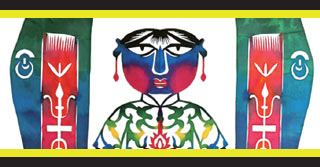
Jin Fengjie |
SPLASH-COLOUR PAPER CUTTING
23 / 08 ~ 11 / 09
2011
Protected by national patent, the art of Liaocheng splashcolour
paper cutting is produced by splashing four colours – red,
yellow, blue and black – onto intricately cut and folded pieces of
paper, producing bright and beautiful works.
Born into a family of paper cutters, Jin Fengjie is credited
as ‘The First Artisan of Splash-colour Paper Cutting in China’, and
she was awarded a national patent for her invention. Jin learned
and began performing the arts of calligraphy, painting and paper
cutting at a young age. With a particularly keen proficiency at
painting coloured flowers, birds and figures, Jin incorporates
elements of modern colour painting, Chinese motifs and decorative
art into the Chinese paper cutting tradition, setting out on the
inventive journey of splash-colour paper cutting. |
| |
|
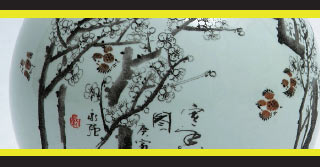
Liu Yongqiang |
PORCELAIN VASE CARVING
13 / 09 ~ 02 / 10
2011
Porcelain Carving is an integrated art involving printmaking,
Chinese painting, oil painting, calligraphy and seal engraving,
distinguished by its skilled use of the knife. The development
of porcelain carving began with simple carvings of words and
seals and then grew into the depiction of diverse motifs such as
landscapes, figures, birds, flowers, animals and calligraphy. The
art uses various blade techniques and lavish colours to create a
range of patterns. Carvings combined with brush-and-ink Chinese
painting are especially effective at creating lifelike illustrations.
A master of Shandong Province’s handcrafts and ceramic
arts, Liu Yongqiang has won awards in several exhibitions and is
an art critic at home and abroad. His work Along the River during
the Qingming Festival took first prize in the 1st National Carving
Competition and was dubbed a ‘Masterpiece of Porcelain Carving’
by arts specialists. |
| |
|
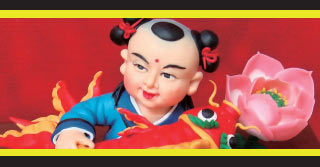
Mu Xujian |
HEZE DOUGH FIGURINES
13 / 09 ~ 02 10
2011
Dough Figurines are representative of Shandong folk culture.
In the city of Heze, traditionally known as Caozhou, the first dough
sculptors customarily fashioned images of pigs and lambs. The
figurines were used as sacrificial substitutes for slaughtered animals
in the worship of heaven and earth and the spirits, meant to solicit
favourable weather for growing crops and protection from the
deities. Later, sculptors mixed vegetable juices into the dough to
add colour, enabling them to create flowers, birds and other figures
– a custom that has lasted to the present day.
A representative heir to the craft of Heze Dough Figurines, Mu
Xujian expressed a keen passion for the art of dough sculpting at an
early age. Having inherited the skills necessary to produce dough
figurines from his forebears, Mu constantly develops and innovates
upon this tradition to produce works imbued with rich folk culture
and embracing diverse themes. |
| |
|
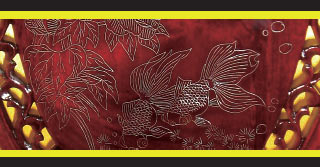
Zhao Zhi |
REDWOOD SILVER INLAY
04 ~ 23 / 10
2011
The redwood silver inlay of Weifang employs redwood, pure
gold wire, silver wire and natural lacquer as raw materials. It then
benefits from skilled carving and mounting techniques. This silver
inlay utilises a wide variety of patterns to create over 100 types of
products from furniture to decorative crafts pieces. Characteristic of
a unique folk culture and emblematic of its origin, redwood silver
inlay is immensely practical and valuable and is especially prized
by collectors. The art has been inscribed on the China’s National
Intangible Cultural Heritage list.
Zhao Zhi has been engaged in the art of sliver inlay for nearly
ten years. After undergoing a rigourous apprenticeship, Zhao
distinguished herself as a supreme master of this art and remains a
constant and creative innovator to this day. |
| |
|
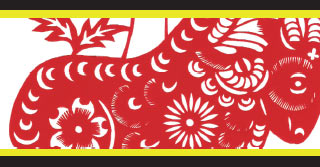
Luan Shujuan |
YANTAI PAPER CUTTING
04 ~ 23 / 10
2011
Yantai paper cutting is also known as chuanghua (literally
‘window decoration’) in Chinese. Yantai paper cutting techniques
form minuscule, thin-lined patterns that depict auspicious motifs.
The images represent people’s desire for a good life and reflect the
simple and humble nature of rural life in the North.
Luan Shujuan demonstrated a keen interest in paper cutting
at an early age. Under the zealous guidance of her grandmother,
she mastered the art’s techniques, becoming a representative
artisan of the Dongfeng School. Devoted to the promotion and
success of paper cutting, Luan has received wide acclaim from
specialists both at home and abroad, and her works have won
several important national awards. |
| |
|
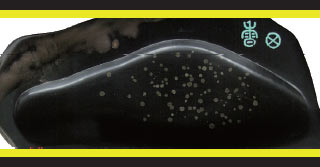
Yao Ziming
|
GOLDSTONE INK SLABS
25 / 10 ~ 13 / 11
2011
Originating in Fei County, goldstone is a rare and precious
material, which sparkles due to its inclusions of pyrite crystals. Ink
slabs made of goldstone are like a night sky bedecked with stars.
The production of goldstone ink slabs involves shaping the stone,
using various carving techniques, into patterns featuring primarily
landscapes and motifs from local legends and culture.
A Shandong folk artisan, Yao Ziming developed a keen
interest in stone carving at a young age. In 1978, he studied at the
Shandong Arts and Crafts Institute, creating many distinguished
goldstone ink slab works. Having inherited the traditional
techniques, Yao began pursuing a modern interpretation, earning
him the title ‘Artisan of Chinese Tradition’ in 2010 from the
committee of the China Traditional Cultural Promotion Project. |
| |
|
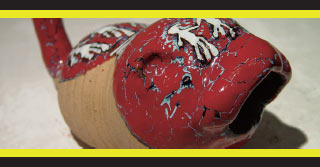
Zhou Shengnan |
ZIBO CERAMIC ARTS
25 / 10 ~ 13 / 11
2011
Founded on a long and distinguished tradition, Shandong’s
Zibo Ceramic Arts have relied on modern scientific technology to
rediscover several precious glaze recipes once considered lost and
to solve the problems associated with adding colour to goldenblack
glaze. In doing so, this revival has given rise to an array of
influential ceramic arts employing the new ‘gold-and-red crystal
glaze’, ‘chicken-red glaze’ and ‘goldstone glaze’ along with several
dozen variants of black glaze, the reputation of which reverberates
throughout the country.
A Shandong ceramic arts master and a visiting professor at
the Tianjin Academy of Fine Arts, Zhou Shengnan has won Gold
Prizes in the Shandong Ceramic Arts Competition and Distinguished
Prizes in the 7th and 8th National Ceramics Competition. His works,
which are extensively collected, primarily focus on flower glaze and
sculptural techniques. |
BACK |







